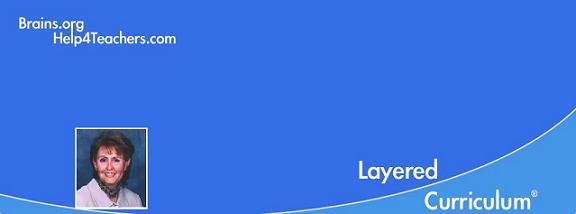__________Layered Curriculum®. . . because every child deserves a special education™_
 |
|
![]() _
_ ![]()
Layered
Curriculum TEXT & WORKBOOK
Set
for only
$43.95
(free shipping in
US)
Tweet
_Asperger's and PDD-NOS Gone! Now What?
The new Autism Spectrum Disorder
© Dr Kathie Nunley, 2016As many of you know by now, 2013 brought in the new Diagnostic and Statistical Manual of Mental Disorders, version 5 (DSM-5). This is the manual published by the American Psychiatric Association and used by clinicians and practitioners as the basis for diagnoses of all mental disorders.
One of the hottest or most discussed changes (and often misunderstood or ignored) is the new criteria for Autism Spectrum Disorder (ASD).
Here is a summary of the main bullet points (elaboration underneath)
No longer will we use the terms Autistic Disorder, Asperger Syndrome, Disintegrative Disorder, or Pervasive Developmental Disorder Not Otherwise Specified (PDD-NOS)
There is now only one diagnosis: Autism Spectrum Disorder (ASD) which is defined as having impairments in two domains: Social / communication / interaction and Restricted and Repetitive Behaviors.
In order to be diagnosed with ASD, a person must have, at some point in early childhood, ALL 3 symptoms from the Social / communication / interaction domain:
- Problems reciprocating social and emotional interactions, inability to initiate interactions and problems sharing emotions with others.
- Severe Problems maintaining relationships. Difficulty in age appropriate social activities.
- Nonverbal communication problems such as inability to understand facial expressions
AND must have 2 of the 4 symptoms from the Restricted and Repetitive Behaviors domain:
- Repetitive speech or motor movement or unusual use of objects.
- Excessive adherence to routines or extreme resistance to change.
- Highly restrictive interests that are abnormal in intensity or focus.
- Hyper or hypo reactivity to sensory input or unusual interest in sensory aspects of environment.
So, in order for a child to be diagnoses with ASD, he or she must exhibit ALL of the 3 symptoms in the top bulleted list and at least 2 from the bottom bulleted list.
Why the Change?
The task force team that worked on this new diagnostic criteria did so in an attempt to clarify what had been a murky field. As has been known for several years, there was no clear demarcation between Autism, Aspergers or even PDD-NOS. Several studies showed that the diagnosis at times simply depended more on the clinic or practitioner who gave the diagnosis rather than the individual being diagnosed!
A New Diagnosis Added
In addition, many people who worked and lived with children on the spectrum felt the ASD classification was getting too broad and moving away from the core symptoms. This may also have led to the addition of a brand new classification in the DSM-5: Pragmatic Social Communication Disorder. Many children who previously would have received a diagnosis of Aspergers under the old DSM IV, may better fit with the new SCD diagnosis of DSM-5, if they are lacking the restricted and repetitive behaviors component.
Important items for parents, counselors, teachers and people with ASD to remember:
1. Anyone who received a firm diagnosis of Autism, Aspergers, or PDDNOS under the old DSM-IV can retain the diagnosis of ASD. They do not need to be re-evaluated.
2. Persons who are comfortable identifying themselves with the label of Aspergers may continue to do so.
3. Medical coding rules for insurance reimbursement are did not change over until October 2014 - and in some medical settings, old codes may continue to be seen or even used.
4. While change is difficult, the general consensus is that this move will be an improvement for children, families and adults with ASD in that it will be a clearer pathway to services.
So, while the semantics may have changed, the mission remains strong. We all continue to research, support and work hard to help persons with ASD take advantage of their strengths to live successful and fulfilling lives
About the Author:
Dr Kathie Nunley is an educational psychologist, researcher and author of several books on parenting and teaching, including A Student's Brain (Brains.org) and the best selling, "Differentiating the High School Classroom" (Corwin Press). She is the developer of the Layered Curriculum® method of instruction and has worked with parents and educators around the world to better structure schools to make brain-friendly environments. In addition, her work has been used by the Boeing Corporation, Family Circle Magazine, the Washington Post, and ABC television.
Email her: Kathie (at) brains.orgCopyright © 1998 - current year by Kathie F. Nunley.
All Rights Reserved.
Layered
Curriculum is a registered trademark developed by
Dr. Kathie F. Nunley.